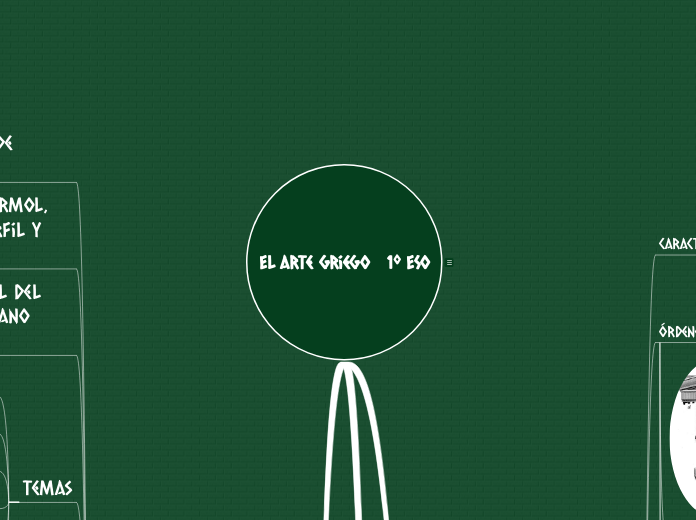por Óscar Quirant Erades 4 anos atrás
827
El arte griego 1º ESO

por Óscar Quirant Erades 4 anos atrás
827

Mais informações
Hola,
Resumir la magnitud de la producción artística de la Antigua Grecia en un mapa mental es una tarea hercúlea. Este recurso tiene como objetivo ayudar al estudio de la materia a los alumnos/as de 1º ESO, y en consonancia, el nivel se ajusta a dicho curso.
Autor: Óscar Quirant.
This ancient civilization of Northeastern Africa is one of the most spectacular of the ancient world. Find out more about the people of Ancient Egypt, their gods and goddesses, magical land and daily life.
Egyptians wore make-up and jewelry because they believed this made them more attractive for the Gods. Also, jewelry was a sign of wealth - the more jewelry someone had, the richer he/she was.

La escultura griega, entonces, se liberó de las convenciones artísticas que habían dominado durante siglos en muchas civilizaciones, y en lugar de reproducir figuras de acuerdo con una fórmula prescrita, eran libres de perseguir la forma idealizada del cuerpo humano.
El material duro y sin vida se transformó mágicamente de alguna manera en cualidades intangibles como el equilibrio, el estado de ánimo y la gracia para crear algunas de las grandes obras maestras del arte mundial e inspirar e influir en los artistas que debían seguir en la época helenística y romana que luego producirían más obras maestras como la Venus de Milo.
Además, la perfección en proporciones del cuerpo humano lograda por los escultores griegos continúa inspirando a los artistas incluso hoy en día. Incluso los grandes artistas consultan las grandes obras griegas para crear imágenes virtuales precisas.
A 'pharaoh' was the supreme political and religious leader of the land. The word 'pharaoh' comes from Greek and it initially related to the designation of a royal residence.
Each pharaoh was usually the son or declared heir of the previous pharaoh, born of the Great Wife (pharaoh’s chief consort) or sometimes a lesser-ranked wife favored by the pharaoh.
Among the over 300 pharaohs in ancient Egypt, only a few of them succeeded to leave behind an eternal legacy.
Los escultores buscaron el movimiento y la expresión de los sentimientos en los rostros y en los cuerpos de las figuras.
Con este fin, se representaron temas de acción y movimiento; o dramáticos como el castigo de Laooconte.
Laocoonte y sus hijos
Las figuras se representaron de forma más natural, aunque idealizadas; es decir, buscan la belleza ideal, el movimiento y las proporciones perfectas guiadas por un canon.
Mirón, Policleto y Fidias fueron los principales exponentes. El canon se estableció que la figura debía poseer una altura de siete veces la cabeza.
Diadumeno de Policleto
Discóbolo de Mirón (Copia romana)
Las figuras se representan en actitudes rígidas (hieratismo). Los brazos pegados al cuerpo en posición de marcha, y con rostros de ojos almendrados y sonrisa contenida, denominada sonrisa arcaica.
Las representaciones más usuales fueron las de atletas desnudos llamados kuroi, y las de figuras femeninas vestidas, conocidas como korai, que probablemente fueran sacerdotisas.
Korai
Kuroi
Guess the Pharaoh
Type in the name of this pharaoh and the period in which she ruled.
Guess the Pharaoh
Type in the name of the ruler and the period in which he reigned.
Guess the Pharaoh
Type in the name of the pharaoh and the period in which he ruled.
Guess the Pharaoh
Type in the name of this important pharaoh and the period in which he ruled. Example: Ahmose I, 1570 - 1546 BC.
Ancient Egyptian Farming
One of the reasons for which this civilization was so successful was the fact that they used farming to produce their own food and cloth. The farmers grew their crops along the bank of the River Nile.
Caracterizado por su capital con hojas de acanto.
Linterna de Lisícrates
Más ligero y decorativo.
Templo de Atenea Niké
El más pesado y sencillo.
El Partenón